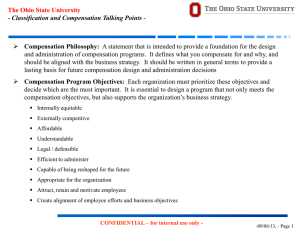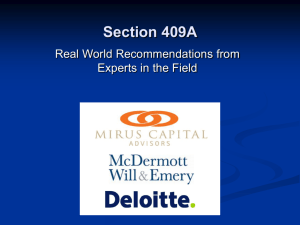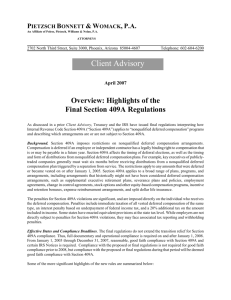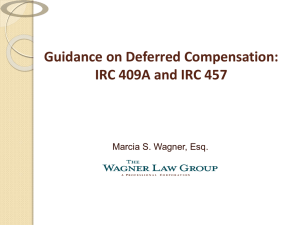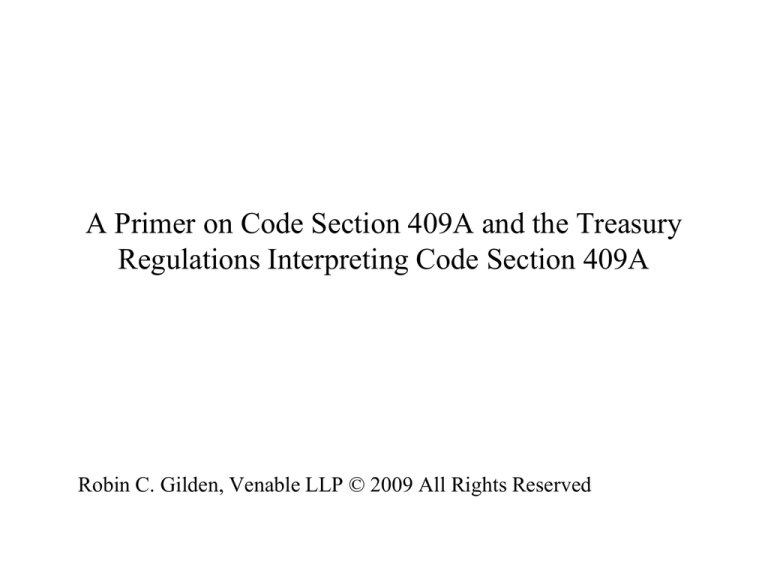
A Primer on Code Section 409A and the Treasury
Regulations Interpreting Code Section 409A
Robin C. Gilden, Venable LLP © 2009 All Rights Reserved
Importance of Section 409A of the Internal Revenue
Code of 1986, As Amended (the “Code”)
•
If a “nonqualified deferred compensation plan” fails to meet the
requirements of Code Section 409A the service provider (i.e. the
person performing the services):
•
Is required to immediately include as ordinary income all amounts
payable under the plan (discounted to present value) and under any
plan that is required to be aggregated with the plan and
•
Is required to pay a penalty tax equal to 20% of the value of the
amounts payable under the plan.
•
If the service provider is subject to income taxes in the State of
California the California Franchise Tax Board (the “FTB”) takes the
position that an additional 20% penalty is payable to California.
2
What Is a Nonqualified Deferred
Compensation Plan for Purposes of Code
Section 409A?
• A “nonqualified deferred compensation plan for purposes
of Code Section 409A is defined as any plan or
arrangement pursuant to which a service provider may
receive compensation in a taxable year later than the
taxable year in which the services are provided to the
service recipient if the plan is not a qualified pension or
profit sharing plan.
3
Exceptions to Code Section 409A—
Short Term Deferrals
•
Code Section 409A does not apply to short-term deferrals
•
A short term deferral occurs where absent an election by the service provider
to otherwise defer compensation, a payment is actually or constructively
received by the service provider by the later of (a) the fifteenth day of the third
month beginning after the end of the service provider’s taxable year in which
a substantial risk of forfeiture lapses or (b) the fifteenth day of the third month
beginning after the end of the service recipient’s taxable year in which a
substantial risk of forfeiture lapses.
•
Where a payment is not subject to a substantial risk of forfeiture, the payment
is deemed to no longer be subject to a substantial risk of forfeiture when the
service provider first has a legal right to the payment.
•
Additionally, the arrangement must not otherwise defer the payment to a later
period.
4
Definition of Substantial Risk of Forfeiture
•
•
•
•
Compensation is subject to a substantial risk of forfeiture if entitlement to the
amount is conditioned on the performance of substantial future services by any
person or the occurrence of a condition related to a purpose of the
compensation, and the possibility of forfeiture is substantial.
A condition related to a purpose of the compensation must relate to the service
provider's performance of services for the service recipient or the service
recipient's business activities or organizational goals (for example, the
attainment of a prescribed level of earnings or equity value or completion of an
initial public offering).
If a service provider's entitlement to the amount is conditioned on the
occurrence of the service provider's involuntary separation from service
without cause, the right is subject to a substantial risk of forfeiture if the
possibility of forfeiture is substantial.
An amount is not subject to a substantial risk of forfeiture merely because the
right to the amount is conditioned, directly or indirectly, upon the refraining
from the performance of services.
5
Exceptions to Code Section 409A – Payment
to Independent Contracts
•
Code Section 409A does not apply to payments made to independent
contractors who meet certain safe harbor requirements
•
The safe harbor applies to an arrangement between an independent contractor
and an unrelated service recipient if during the service provider's taxable year
in which the service provider obtains a legally binding right to the deferred
amount, the service provider is actively engaged in the trade or business of
providing services (other than as an employee or as a director of a corporation)
and provides significant services to two or more service recipients to which the
service provider is not related and that are not related to one another and the
revenues generated from the services provided to any service recipient or
group of related service recipients during such taxable year do not exceed 70%
of the total revenues generated by the service provider from the trade or
business of providing such services.
•
Understanding these rules depends upon interpreting what receipts are deemed
to be received in a year.
6
Exceptions to Code Section 409A – Certain
Stock Options and Stock Appreciation Rights
•
•
•
•
Stock options are not subject to Code Section 409A provided that the exercise
price of the option is not less than the fair market value of the stock on the date
that the option is granted and the stock option does not contain any other
deferral feature.
A service provider must receive stock of a service recipient in order to satisfy
these rules. There are detailed rules regarding what is service recipient stock.
Where a service recipient’s stock is not publicly traded, the fair market value
of the stock must be determined by a reasonable application of a reasonable
valuation method. There are detailed rules regarding what is meant by a
reasonable valuation method.
Discounted stock options (stock options that have an exercise price that is less
than the fair market value of the subject stock when the options are granted)
will violate Code Section 409A unless they meet the short term deferral rules
(i.e. the option must be exercised by the 15th day of the third month after the
end of the taxable year in which the option is granted).
7
Exceptions to Code Section 409A – Phantom Stock
Rights or Stock Appreciation Rights (“SARs”)
• SARs are not subject to Code Section 409A if
• The SAR grant refers to a specified number of shares of
stock (or certain percentage of equity interest).
• On the exercise of the SAR the recipient cannot receive an
amount greater that the excess of the fair market value of
the specified number of shares on the date of exercise in
excess of the fair market value of those shares on the date
of the grant and
• The SAR cannot contain any other deferral feature.
8
Application of Code Section 409A
• Code Section 409A has three requirements
• An election requirement
• A time of payment requirement
• Rules prohibiting the acceleration of a payment once an
election has been made
9
Election Requirement
• Where a service provider has the right to elect to defer compensation,
the election to defer generally must be made by the end of the service
provider’s taxable year immediately preceding the taxable year in
which the services will be performed.
• In the first year in which the service provider becomes eligible to
participate in a plan, the service provider may make an initial deferral
election within 30 days after the date the service provider becomes
eligible to participate in such plan, with respect to compensation paid
for services to be performed after the election.
• Where the service provider does not have the right to elect to defer, the
election must be made by no later than the later of the time the service
provider first has a legally binding right to the compensation or, if
later, the time the service provider would be required to make such an
election if the service provider were provided such an election.
10
Subsequent Deferral Elections
• Once the service recipient has made or been deemed to make an
election, the service recipient cannot change the election to further
defer the election unless the following requirements are met:
• The plan requires that such election may not take effect until at least 12
months after the date on which the subsequent deferral election is
made;
• In the case of an election that is not related to a payment on account of
disability, on account of death or on account of the occurrence of an
unforeseeable emergency, the plan requires that the payment with
respect to which such election is made must be deferred for a period of
not less than five years from the date such payment would otherwise
have been paid and
• The plan requires that any election related to a payment at a specified
time or pursuant to a fixed schedule may not be made less than 12
months before the date the payment is scheduled to be paid.
11
Time and Form of Payment Requirements
• Payments of deferred compensation can be made only at
the following times:
• At a time (or pursuant to a fixed schedule) specified under
the plan;
• Upon the service provider's separation from service;
• Upon the service provider's becoming disabled;
• Upon the service provider's death;
• Upon a change in the ownership or effective control of the
service recipient or in the ownership of a substantial
portion of the assets of the service recipient; or
• Upon the occurrence of an unforeseeable emergency
12
Time or Fixed Schedule Specified in the
Plan
• This can be a fixed date (such as September 1, 2011).
• It can be any time that is objectively determinable and
nondiscretionary at the time the event occurs (i.e. the
release of a motion picture).
• It can also be a designated taxable year of the service
provider (i.e. the taxable year of the service provider
occurring after the release of a motion picture) if the period
of time does not span more than one taxable year or a
period of no longer than 90 days even if the period
straddles two taxable years, as long as the service provider
cannot designate the taxable year in which the payment
will be made.
13
Service Provider’s Separation From Service
•
•
•
An employee is considered to have separated from service with the service
recipient if the employee dies, retires or otherwise has a termination of
employment with the employer. However, the employment relationship is
treated as continuing intact while the individual is on military leave, sick leave
or other bona fide leave of absence if the period of such leave does not exceed
six months, or if longer, so long as the individual's right to reemployment with
the service recipient is provided either by statute or by contract.
If the period of leave exceeds six months and the individual's right to
reemployment is not provided either by statute or by contract, the employment
relationship is deemed to terminate on the first date immediately following
such six-month period.
Under the regulations, whether a termination of employment has occurred is
determined based on whether the facts and circumstances indicate that the
employer and employee reasonably anticipated that no further services would
be performed after a certain date or that the level of bona fide services the
employee would perform after such date (whether as an employee or as an
independent contractor) would permanently decrease to no more than 20% of
the average level of bona fide services performed (whether as an employee or
an independent contractor) over the immediately preceding 36-month period
(or the full period of services to the employer if the employee has been
providing services to the employer less than 36 months).
14
Special Rule Concerning Specified Employees
• If a service provider is a specified employee (as defined in
Treasury Regulations) as of the date of a separation from
service, the rules permitting a payment upon a separation
from service are satisfied only if payments may not be
made before the date that is six months after the date of
separation from service (or, if earlier, the date of death of
the specified employee).
• The specified employee rules only apply to certain highly
compensated employees of publicly held corporations
15
Separation Pay Plans
•
•
•
•
•
•
•
Code Section 409A does not apply to certain Separation Pay Plans
A Separation Pay Plan is an arrangement that meets the following requirements:
(1) The separation pay (other than reimbursements and certain other separation
payments) may not exceed two times the lesser of:
(a) the sum of the service provider's annualized compensation based upon the annual
rate of pay for services provided to the service recipient for the taxable year of the
service provider preceding the taxable year of the service provider in which the service
provider has a separation from service with such service recipient (adjusted for any
increase during that year that was expected to continue indefinitely if the service
provider had not separated from service), or
(b) the maximum amount that may be taken into account under a qualified plan pursuant
to Code Section 401(a)(17) ($245,000 for 2009) for the year in which the service
provider has a separation from service; and
(2) The separation pay must be paid no later than the end of the second taxable year
following the taxable year in which the separation from service occurs.
Additionally, the amount is payable to an employee only upon an involuntary separation
from service or for “good reason” as defined in the Treasury Regulations .
16
Reimbursement Plans
•
•
•
Certain reimbursement arrangements related to a termination of services are
not covered by Code Section 409A, to the extent that the reimbursement
arrangement covers only expenses incurred and reimbursed before the end of
the second year following the year in which the termination occurs.
The types of reimbursement arrangements excluded include reimbursements
that are otherwise excludible from gross income for expenses that the service
provider can deduct under Code Section 162 or 167 as business expenses
incurred in connection with the performance of services (ignoring any
applicable limitation based on adjusted gross income), outplacement expenses,
moving expenses, medical expenses, as well as any other types of payments
that do not exceed a certain aggregate amount during any given taxable year.
Reimbursement arrangements include the provision of in-kind benefits or
direct payments by the service recipient to the person providing the goods or
services to the terminated service provider, if the provision of such in-kind
benefits or direct payments would be treated as reimbursement arrangements if
the service provider had paid for such in-kind benefits or such goods or
services and received reimbursement from the service recipient
17
Disability of Service Provider, Unforeseen
Emergency
• The Treasury Regulations under Code
Section 409A provide definitions of
“disability” and “unforeseen emergency.”
18
Change in Ownership or Effective Control or
Change in Ownership of a Substantial Portion of
Assets
•
•
•
•
To qualify as a change in ownership or effective control, the occurrence of the event
must be objectively determinable and any requirement that any person certify the
occurrence of the change in ownership or effective control must be strictly ministerial.
A change in ownership occurs if a person or group of persons acquires ownership of
stock of the corporation that, together with stock held by such person or group,
constitutes more than 50% of the total fair market value or total voting power of the
stock of such corporation.
A change effective control of a corporation occurs if either (a) ownership of stock of the
corporation possessing 30% or more of the total voting power of the stock of such
corporation or (b) the date a majority of members of the corporation's board of directors
is replaced during any 12-month period by directors whose appointment or election is
not endorsed by a majority of the members of the corporation's board of directors before
the date of appointment or election.
A change in ownership of a substantial portion of a corporation’s assets occurs when
any one person, or more than one person acting as a group acquires (or has acquired
during the 12-month period ending on the date of the most recent acquisition by such
person or persons) assets from the corporation that have a total gross fair market value
equal to or more than 40% of the total gross fair market value of all of the assets of the
corporation immediately before such acquisition or acquisitions.
19
No Acceleration of Deferred Compensation
• An acceleration of deferred compensation violates Code Section 409A
unless the acceleration qualifies for an exception provided in the
Treasury Regulations
• A payment of an amount as a substitute for a payment of deferred
compensation will be treated as a payment of the deferred
compensation, including for purposes of the prohibition on accelerated
payments.
• If a service provider's rights to deferred compensation are subject to
anticipation, alienation, sale, transfer, assignment, pledge,
encumbrance, attachment or garnishment by creditors of the service
provider or the service provider's beneficiary, such amounts are treated
as having been paid to the service provider.
• The receipt of a payment of compensation or right to a payment of
compensation proximate to the purported forfeiture or voluntary
relinquishment of a right to deferred compensation generally is treated
as a substituted payment for the payment of the deferred compensation.
20



